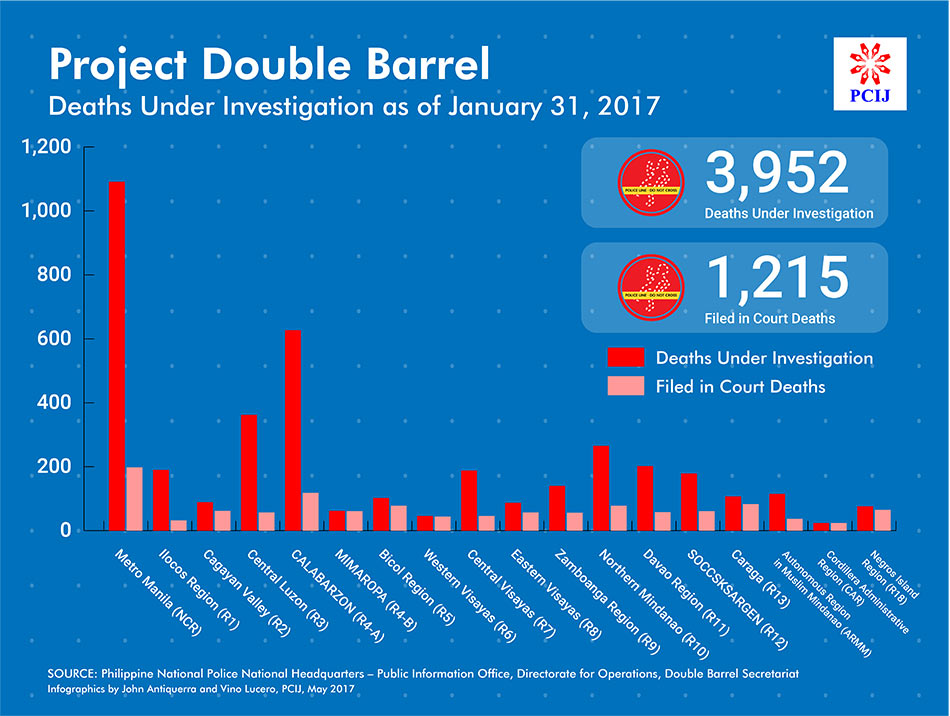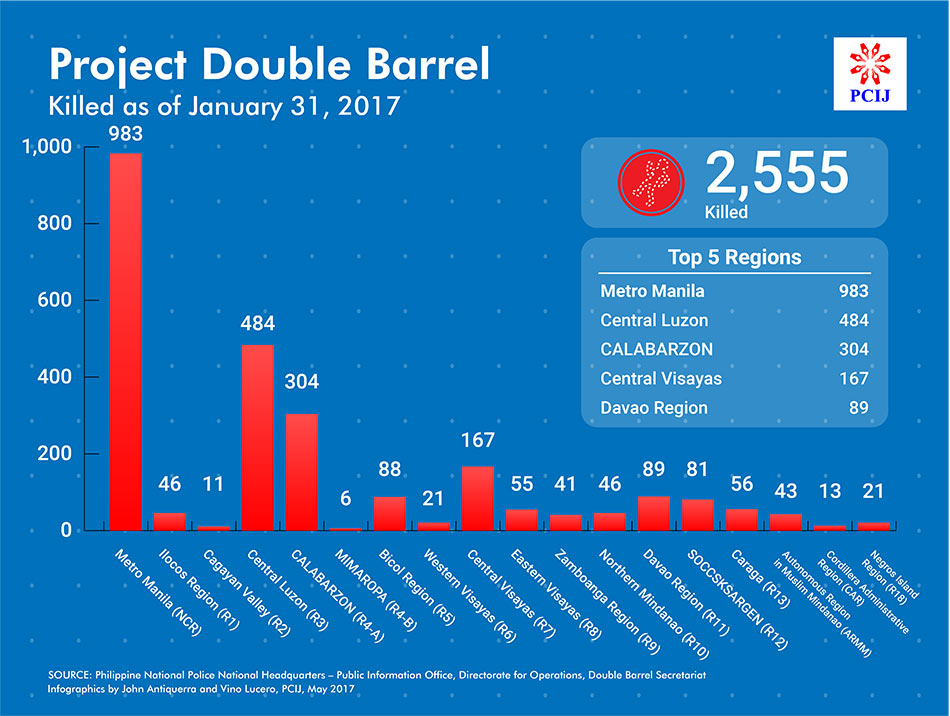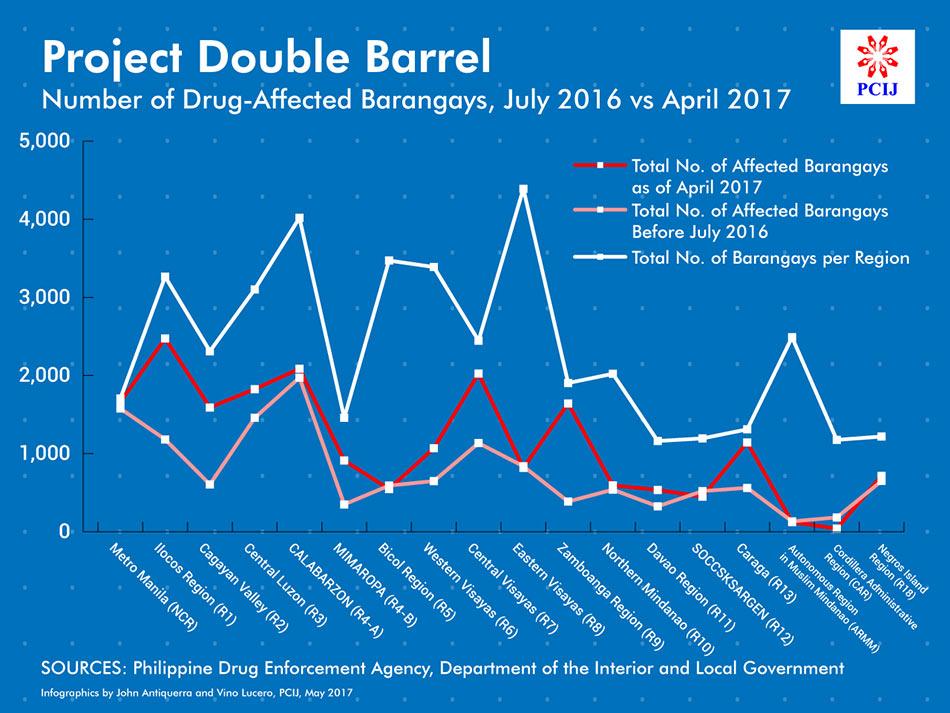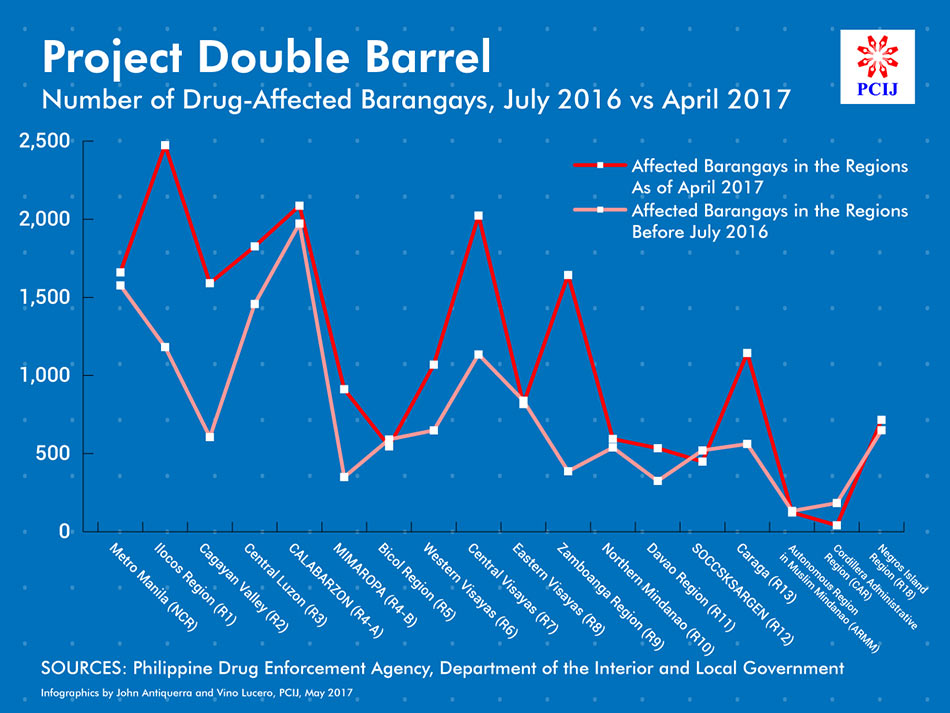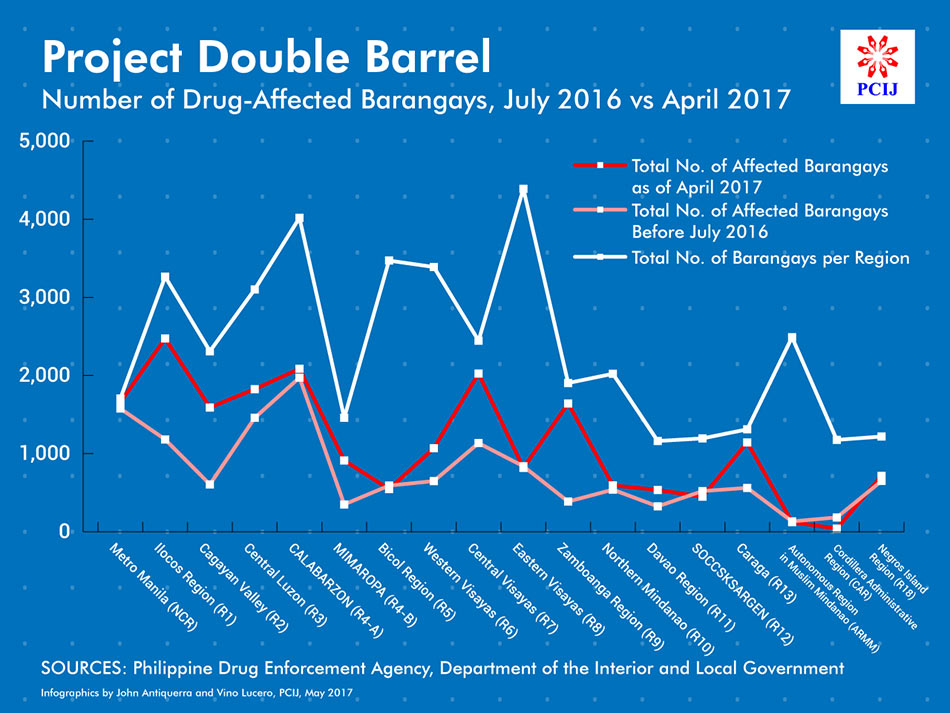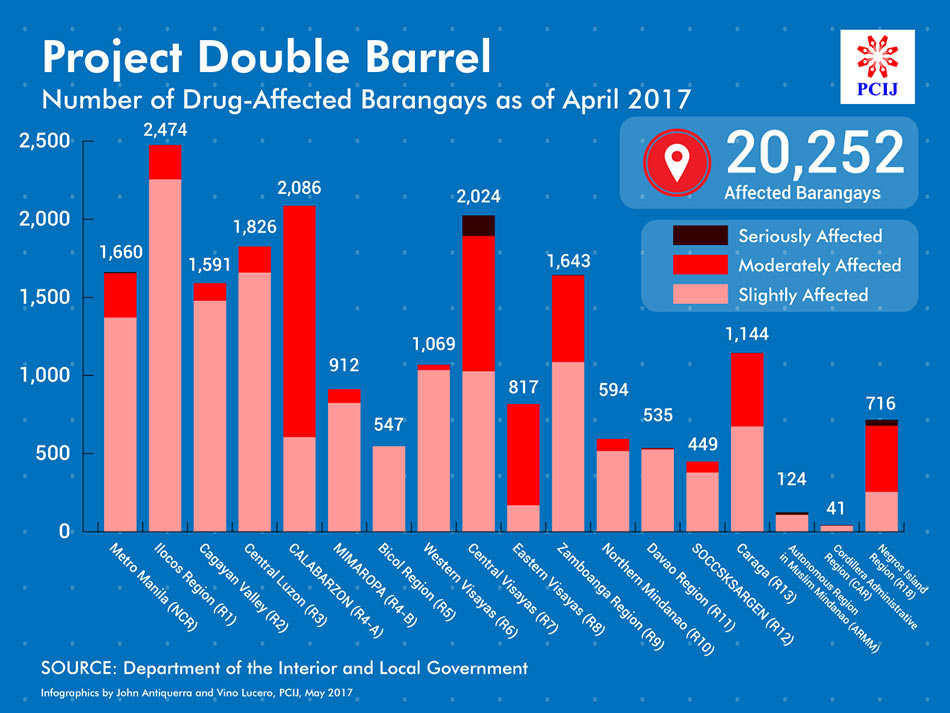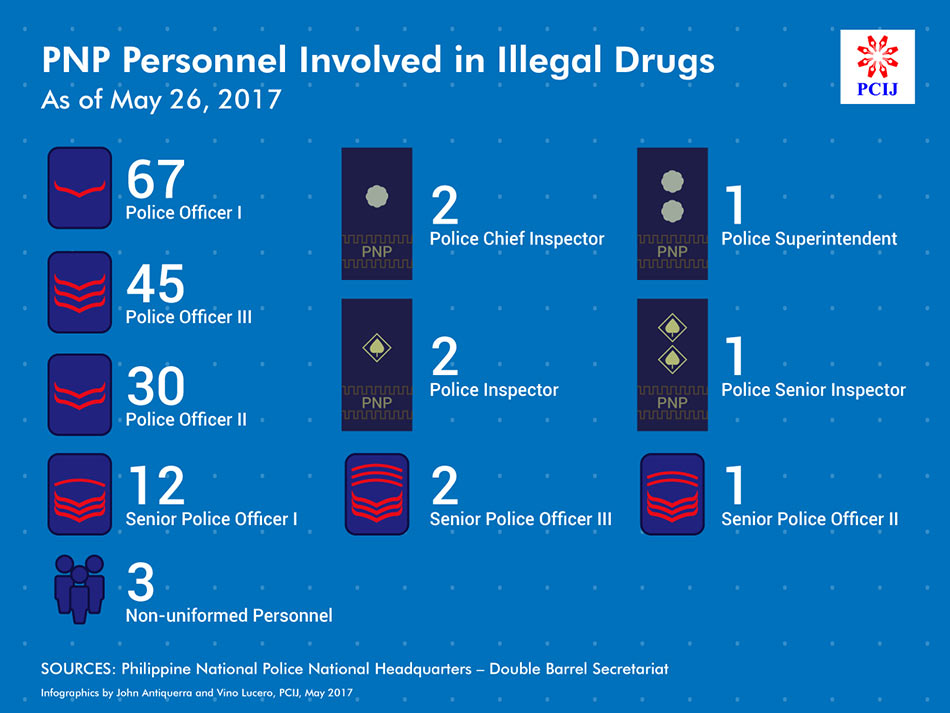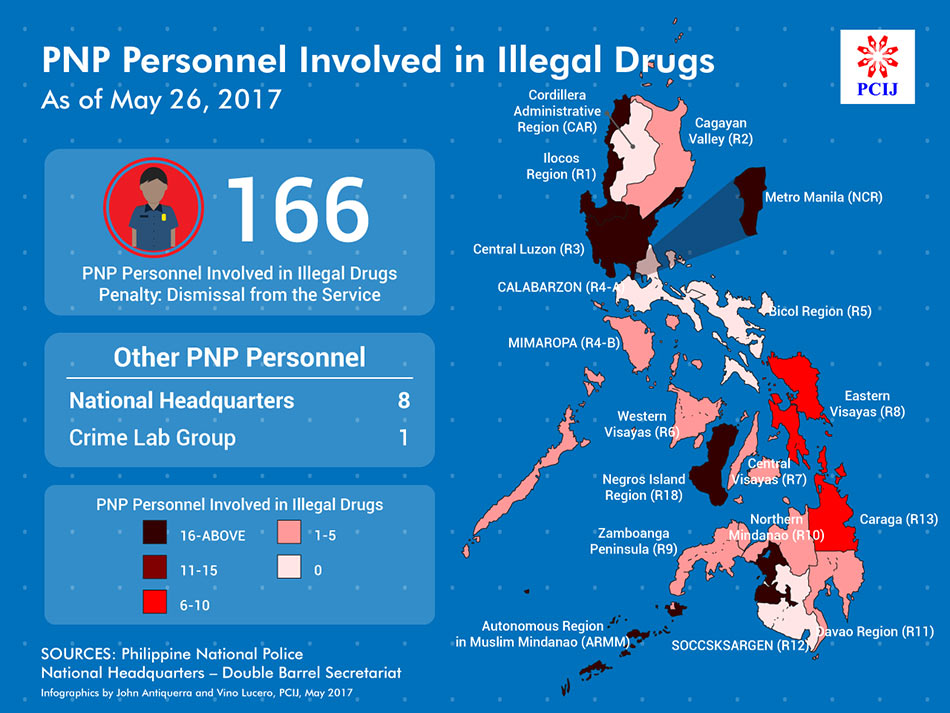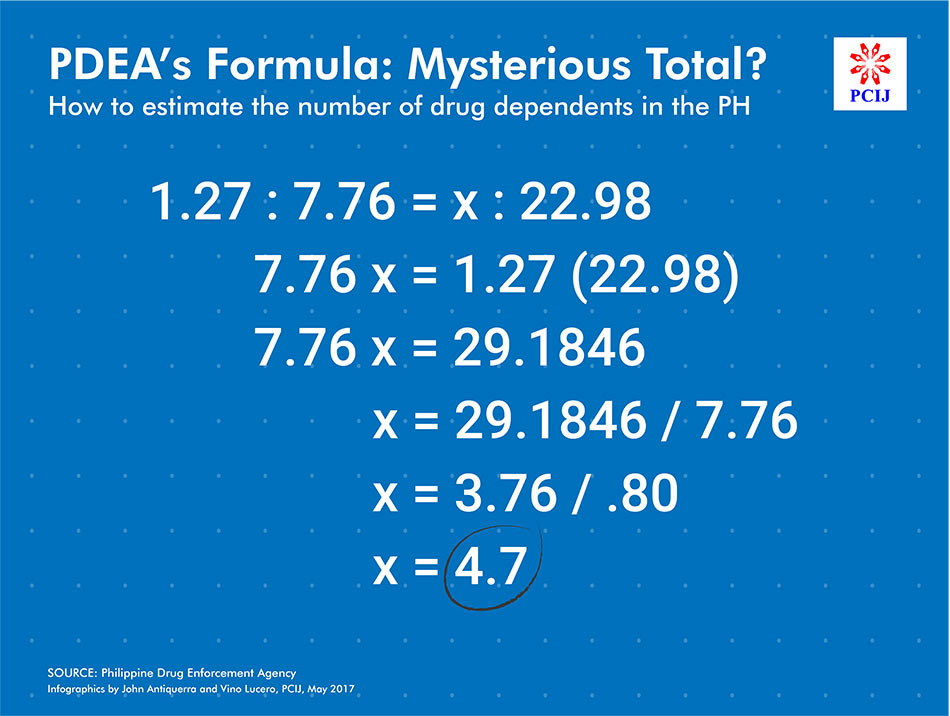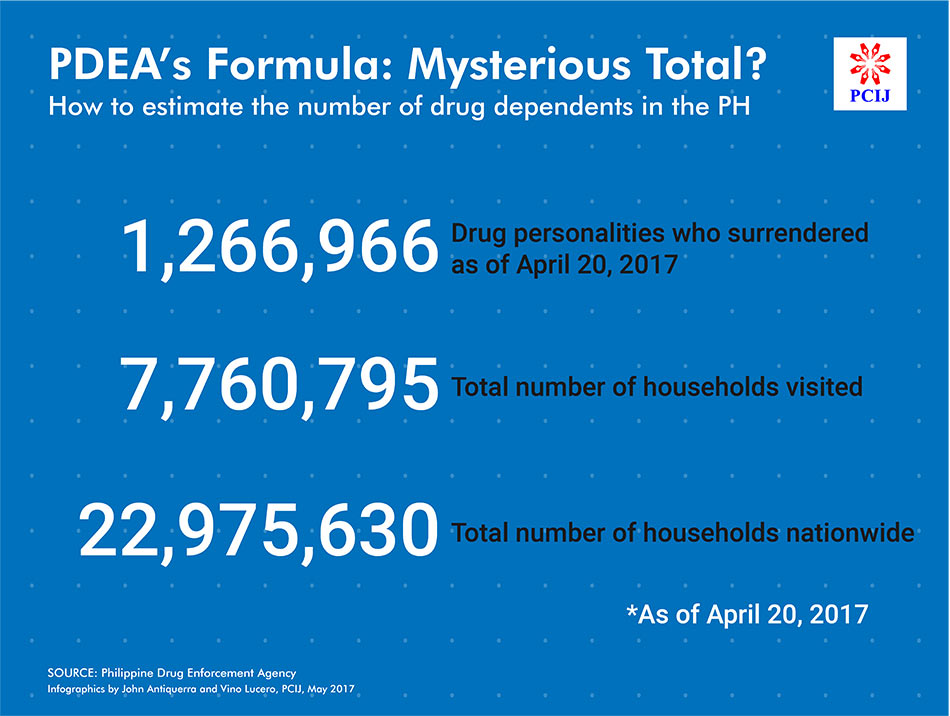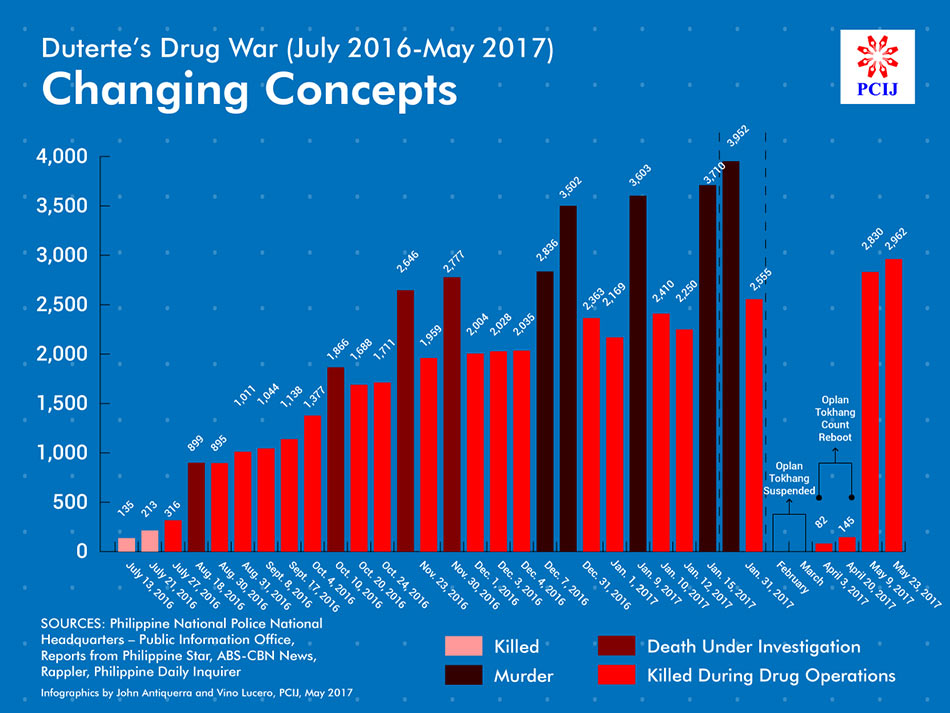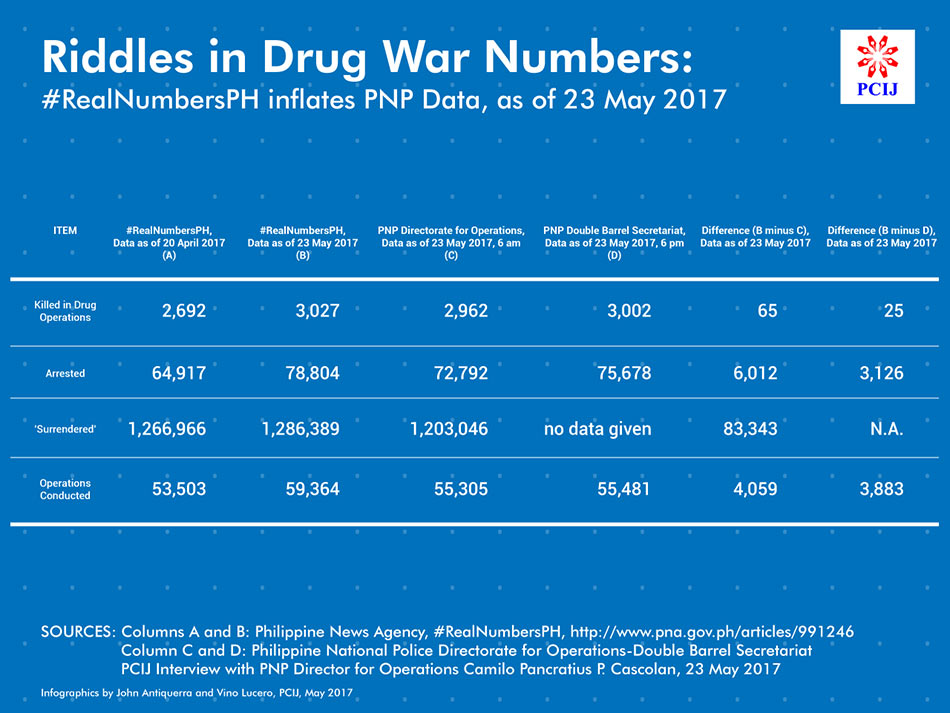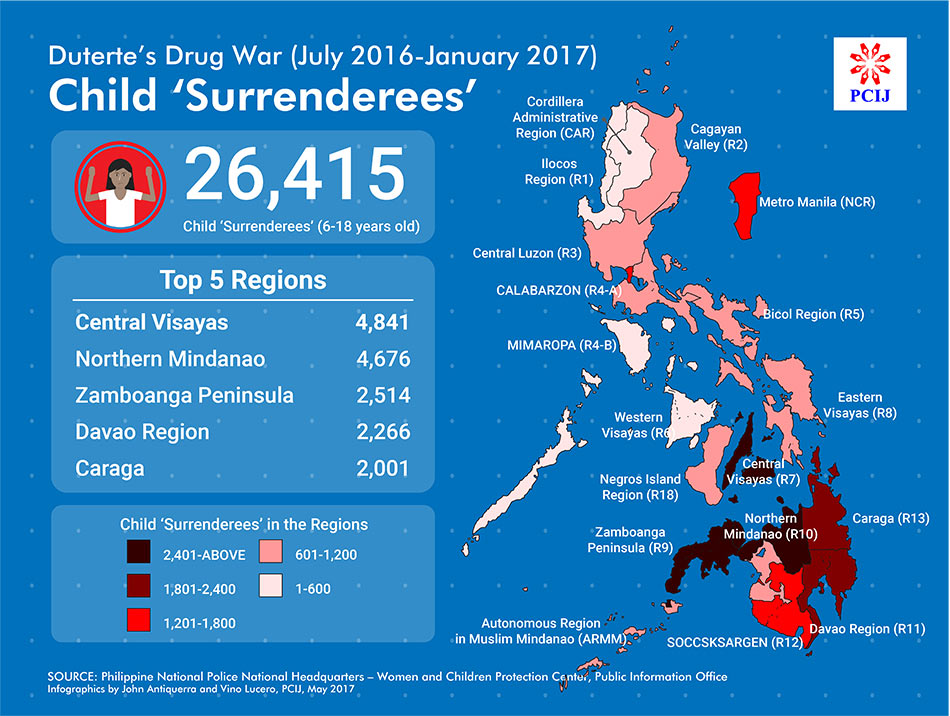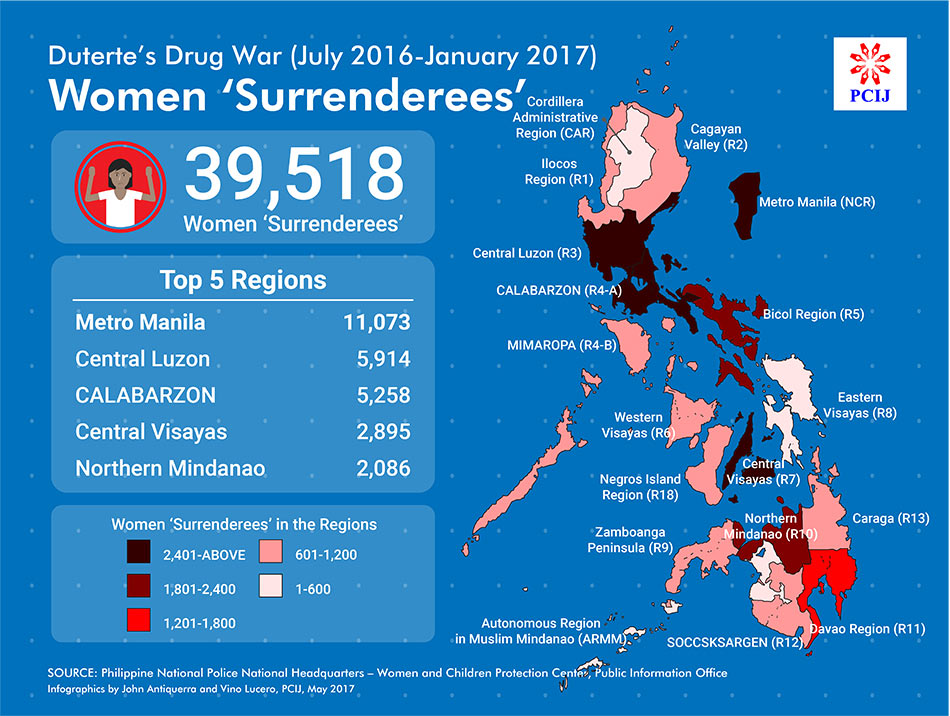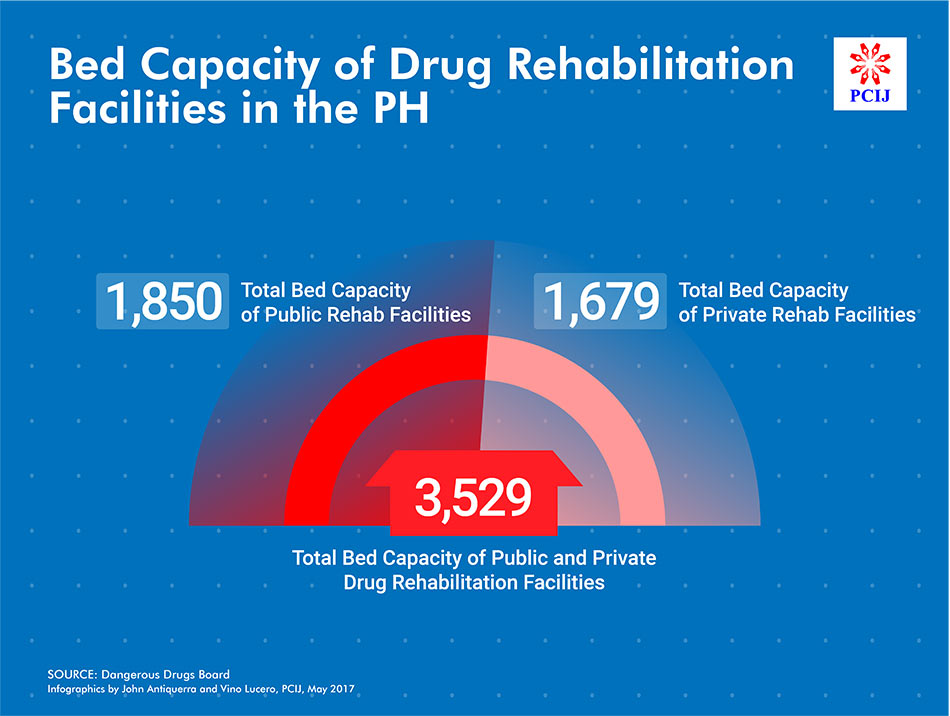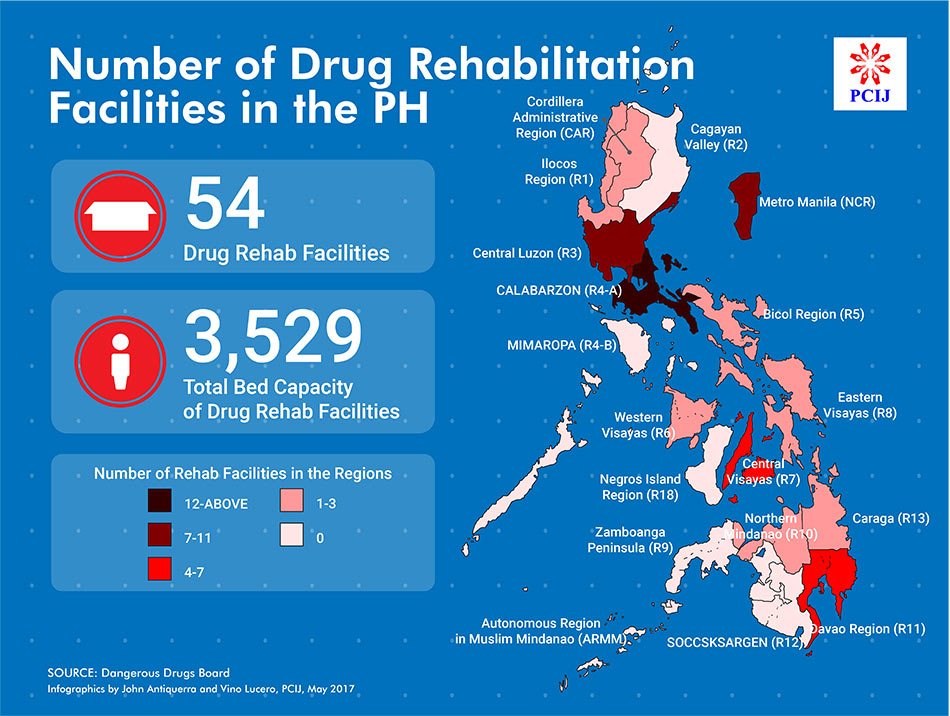PCIJ findings: What's flawed, fuzzy with drug war numbers?
ADVERTISEMENT

Welcome, Kapamilya! We use cookies to improve your browsing experience. Continuing to use this site means you agree to our use of cookies. Tell me more!
PCIJ findings: What's flawed, fuzzy with drug war numbers?
The Philippine Center for Investigative Journalism
Published Jun 08, 2017 10:27 PM PHT
|
Updated Jun 09, 2017 02:35 PM PHT
PRESIDENT RODRIGO R. Duterte has repeatedly said that drugs are the root of society’s many ills. He also seems to see drugs everywhere and in almost anything, even in the ongoing conflict in Marawi. Yet even as his administration’s controversial war against illegal drugs continues to claim lives, it has also spawned a side battle over numbers and public-relation points.
PRESIDENT RODRIGO R. Duterte has repeatedly said that drugs are the root of society’s many ills. He also seems to see drugs everywhere and in almost anything, even in the ongoing conflict in Marawi. Yet even as his administration’s controversial war against illegal drugs continues to claim lives, it has also spawned a side battle over numbers and public-relation points.
Earlier last month, the newly created Inter-Agency Committee on Anti-Illegal Drugs (ICAD) launched #RealNumbersPH, an official report that supposedly offers the true and correct numbers on the drug war -- from the government's perspective. ICAD officials lamented what they called the misreporting and exaggeration by the news media of the numbers of those who were killed, arrested, or surrendered. What the ICAD officials left out was that most of those stories were based on information provided by the Philippine National Police (PNP) and other official sources.
Earlier last month, the newly created Inter-Agency Committee on Anti-Illegal Drugs (ICAD) launched #RealNumbersPH, an official report that supposedly offers the true and correct numbers on the drug war -- from the government's perspective. ICAD officials lamented what they called the misreporting and exaggeration by the news media of the numbers of those who were killed, arrested, or surrendered. What the ICAD officials left out was that most of those stories were based on information provided by the Philippine National Police (PNP) and other official sources.
In fact, the government’s drug war narrative so far has not only been bloody, it has also been blurry. Although government officials have not denied that lives have been lost in the anti-drug campaign, they have yet to explain its narrative that is crowded with constantly changing concepts and terms, even as it is decked in numbers inflated then deflated and later inflated again. Indeed, it is a narrative defined from a war waged mainly as a police operation, its “accomplishments” or success pegged on an ever-lengthening trail of bodies and victims, but with no certain answers for whence or how it should end, and bereft of solid baselines and firm targets.
In fact, the government’s drug war narrative so far has not only been bloody, it has also been blurry. Although government officials have not denied that lives have been lost in the anti-drug campaign, they have yet to explain its narrative that is crowded with constantly changing concepts and terms, even as it is decked in numbers inflated then deflated and later inflated again. Indeed, it is a narrative defined from a war waged mainly as a police operation, its “accomplishments” or success pegged on an ever-lengthening trail of bodies and victims, but with no certain answers for whence or how it should end, and bereft of solid baselines and firm targets.
Over the last 11 months, PCIJ has been monitoring, collecting, curating, and organizing data and documents on the government’s war against drugs. It has also sent dozens of request letters to the PNP, the Philippine Drug Enforcement Agency (PDEA), the Dangerous Drugs Board (DDB), the Department of Health, the Department of Social Welfare and Development, the Department of Budget and Management, the Department of the Interior and Local Government, as well as police regional and local commands to build a database on the drug war. To clarify the numbers enrolled in #RealNumbersPH and gather even more data, PCIJ also conducted separate interviews with senior officials of the PNP, PDEA, and DDB.
Over the last 11 months, PCIJ has been monitoring, collecting, curating, and organizing data and documents on the government’s war against drugs. It has also sent dozens of request letters to the PNP, the Philippine Drug Enforcement Agency (PDEA), the Dangerous Drugs Board (DDB), the Department of Health, the Department of Social Welfare and Development, the Department of Budget and Management, the Department of the Interior and Local Government, as well as police regional and local commands to build a database on the drug war. To clarify the numbers enrolled in #RealNumbersPH and gather even more data, PCIJ also conducted separate interviews with senior officials of the PNP, PDEA, and DDB.
ADVERTISEMENT
Ironically, in the course of its data inquiries, PCIJ found some of the numbers enrolled in reports of #RealNumbersPH to be puzzling at best and too incredible at the very least. (See related story: #RealNumbersPH unreal, inexact, locked in riddles)
Ironically, in the course of its data inquiries, PCIJ found some of the numbers enrolled in reports of #RealNumbersPH to be puzzling at best and too incredible at the very least. (See related story: #RealNumbersPH unreal, inexact, locked in riddles)
That, however, is just one of the multiplying number riddles in the government’s anti-drug campaign.
That, however, is just one of the multiplying number riddles in the government’s anti-drug campaign.
By their own data and documents, and according to senior officials from the PNP, PDEA, and DDB interviewed by PCIJ, the Duterte administration's drug war remains wrapped in weak, flabby, misleading, and not sufficiently explained and meaningful data and numbers.
By their own data and documents, and according to senior officials from the PNP, PDEA, and DDB interviewed by PCIJ, the Duterte administration's drug war remains wrapped in weak, flabby, misleading, and not sufficiently explained and meaningful data and numbers.
The most confounding number of all is the correct estimate of the total number of alleged drug users in the country. Is it 1.8 million, according to DDB? Or is it four million, according to President Duterte and PDEA -- or 4.7 million, the latest from PDEA’s new formula?
The most confounding number of all is the correct estimate of the total number of alleged drug users in the country. Is it 1.8 million, according to DDB? Or is it four million, according to President Duterte and PDEA -- or 4.7 million, the latest from PDEA’s new formula?
It must be stressed that the officials interviewed from all the three agencies admit that these figures are not hard, real numbers. And since they all could be correct only in the particular context in which they were derived, this means they could also be wrong when used outside of that context.
It must be stressed that the officials interviewed from all the three agencies admit that these figures are not hard, real numbers. And since they all could be correct only in the particular context in which they were derived, this means they could also be wrong when used outside of that context.
ADVERTISEMENT
In other words, 11 months into the deployment of Oplan Tokhang and Project Double Barrel, the matter of how many total drug users must be snared or coaxed to surrender under Duterte's drug war remains an unsettled issue.
In other words, 11 months into the deployment of Oplan Tokhang and Project Double Barrel, the matter of how many total drug users must be snared or coaxed to surrender under Duterte's drug war remains an unsettled issue.
DDB's 1.8-million estimate of total drug dependents was derived from a 2015 survey that divided the country into five "regional groupings": Metro Manila, North Luzon, South Luzon, Visayas, and Mindanao.
DDB's 1.8-million estimate of total drug dependents was derived from a 2015 survey that divided the country into five "regional groupings": Metro Manila, North Luzon, South Luzon, Visayas, and Mindanao.
The survey aimed to reasonably represent male and female Filipino population aged 10 to 69 years old. After mathematical computations, the survey concluded that the minimum required sample size per regional group would be 838, or a total of 4,190 respondents. But apparently because it had ample available survey funding, the team raised the sample size to 1,000 per regional group, bringing total sample size to 5,000. Field work for the survey was conducted from Dec. 5, 2015 to Feb. 5, 2016.
The survey aimed to reasonably represent male and female Filipino population aged 10 to 69 years old. After mathematical computations, the survey concluded that the minimum required sample size per regional group would be 838, or a total of 4,190 respondents. But apparently because it had ample available survey funding, the team raised the sample size to 1,000 per regional group, bringing total sample size to 5,000. Field work for the survey was conducted from Dec. 5, 2015 to Feb. 5, 2016.
Of the 5,000 respondents, 4,694 or almost 94 percent were categorized to be "non-users" or had "never used drugs before," including 102 who were not aware of any kind of illegal drugs. Only 306 or six percent of the total respondents were "lifetime users" or had used drugs at least once in their lifetime. Of these "lifetime users," 193 or 63 percent had "used drugs before 2015" while 113 or 34 percent were "current users" or had "used drugs within January 2015 and February 2016.” Of the 113 "current users,” 39 (35 percent) were "one-time users," and 74 (65 percent) were "repeat users."
Of the 5,000 respondents, 4,694 or almost 94 percent were categorized to be "non-users" or had "never used drugs before," including 102 who were not aware of any kind of illegal drugs. Only 306 or six percent of the total respondents were "lifetime users" or had used drugs at least once in their lifetime. Of these "lifetime users," 193 or 63 percent had "used drugs before 2015" while 113 or 34 percent were "current users" or had "used drugs within January 2015 and February 2016.” Of the 113 "current users,” 39 (35 percent) were "one-time users," and 74 (65 percent) were "repeat users."
For much of the ongoing drug war, the PNP has chosen to use the estimate of 1.8 million drug users as basis for calculating its success or passing rate in the government’s anti-drug campaign. A PNP document dated Jan. 10 includes an “accounting of drug personalities” portion that cites 70 percent of the 1.8 million estimate number of alleged drug users as the “passing target.” That means PNP considered coaxing the surrender of 1.26 million of the total estimated drug users as its passing rate. By the time the document came out, police tallies already had more than 1.43 million of what it called "surrenderers." By its own reckoning thus, the PNP had already hit its minimum target at that point.
For much of the ongoing drug war, the PNP has chosen to use the estimate of 1.8 million drug users as basis for calculating its success or passing rate in the government’s anti-drug campaign. A PNP document dated Jan. 10 includes an “accounting of drug personalities” portion that cites 70 percent of the 1.8 million estimate number of alleged drug users as the “passing target.” That means PNP considered coaxing the surrender of 1.26 million of the total estimated drug users as its passing rate. By the time the document came out, police tallies already had more than 1.43 million of what it called "surrenderers." By its own reckoning thus, the PNP had already hit its minimum target at that point.
ADVERTISEMENT
President Duterte, however, had initially quoted a 3-million figure but soon turned consistent in insisting that there are four million drug dependents in the country, with the figure allegedly coming from “intelligence reports.”
President Duterte, however, had initially quoted a 3-million figure but soon turned consistent in insisting that there are four million drug dependents in the country, with the figure allegedly coming from “intelligence reports.”
Recently, though, PDEA did him even better, saying that drug users in the Philippines now total 4.7 million. This estimate was derived using PDEA’s "formula ratio and proportion," which is in turn pegged on the number of surrenderees as a ratio of total households visited under Oplan Tokhang, divided by total number of households in the Philippines, and with a margin of error of 20 percent (supposedly representing the proportion of drug personalities "who did not surrender").
Recently, though, PDEA did him even better, saying that drug users in the Philippines now total 4.7 million. This estimate was derived using PDEA’s "formula ratio and proportion," which is in turn pegged on the number of surrenderees as a ratio of total households visited under Oplan Tokhang, divided by total number of households in the Philippines, and with a margin of error of 20 percent (supposedly representing the proportion of drug personalities "who did not surrender").
This is PDEA's formula: "The number of total houses visited (under Oplan Tokhang) is to the number of surrenderers is equal to X. Based on the said statistical computation, with a margin of error of 20% - those who did not cooperate with the law enforcers during the house visitation, there are 4.7 million drug users in the Philippines."
This is PDEA's formula: "The number of total houses visited (under Oplan Tokhang) is to the number of surrenderers is equal to X. Based on the said statistical computation, with a margin of error of 20% - those who did not cooperate with the law enforcers during the house visitation, there are 4.7 million drug users in the Philippines."
According to PDEA, its formula makes this assumption: "For every eight households, there is one drug personality in the household."
According to PDEA, its formula makes this assumption: "For every eight households, there is one drug personality in the household."
Thus, based on data derived from police intelligence and operations reports, PDEA asserts that as of May 18, 2017, "the real number of drug users in the Philippines is 4.7 million."
Thus, based on data derived from police intelligence and operations reports, PDEA asserts that as of May 18, 2017, "the real number of drug users in the Philippines is 4.7 million."
ADVERTISEMENT
Then again, a "house" is not exactly a "household" -- a difference that PDEA's formula ignores. A household represents both the house and its dwellers -- "a social unit consisting of a person living alone or a group of persons who sleep in the same housing unit and have a common arrangement in the preparation and consumption of food," according to the Philippine Statistics Authority. In contrast, a "house" refers only to the physical dwelling.
Then again, a "house" is not exactly a "household" -- a difference that PDEA's formula ignores. A household represents both the house and its dwellers -- "a social unit consisting of a person living alone or a group of persons who sleep in the same housing unit and have a common arrangement in the preparation and consumption of food," according to the Philippine Statistics Authority. In contrast, a "house" refers only to the physical dwelling.
Yet a lot more numbers that government uses and #RealNumbersPH reports to define the drug war remain flawed and flabby on two levels: their accuracy on the level of facts and context; and their policy implications.
Yet a lot more numbers that government uses and #RealNumbersPH reports to define the drug war remain flawed and flabby on two levels: their accuracy on the level of facts and context; and their policy implications.
On the level of facts and context:
On the level of facts and context:
- Some numbers need further validation from original sources. For example, PNP ground units enroll numbers by mistake or double-reporting errors, hence the slide up and down in the number of those killed and arrested between December 2016 and January 2017. The PNP says that this has happened because incident reports are instantaneously sent to the PNP's National Operations Center but that it takes a week for investigating teams and regional commanders to validate and consolidate their reports on the same incidents.
- Some numbers had been clustered under categories that the police had changed arbitrarily over time, and may thus raise questions about numbers shaving or double counting. These include the shift from categories of DUIs (death under investigation, by August 2016, though already defined at this point as murder cases), to MCUI (murder cases under investigation, by January 2017), to HCUI (homicide cases under investigation, by March 2017); and from "killed" in July 2016 reports to “killed in police operations” from August 2016 to January 2017, to "died" in police operations (by March 2017). Ever-changing disaggregation of DUI, MCUI, and HCUI figures, by status, death, or incidents, have also paved the way to another level of confusion in clustering and comparing the numbers.
- The rehabilitation and reintegration of an estimated 1.3 million "surrenderees" (as of May 2017) remain the biggest gaps in the services that ICAD must address. DDB says that by World Health Organization standards, only one percent of the total estimated drug users in a country may require inpatient care. The police's punitive operations, however, do not make this distinction among those who had surrendered, or even between active and non-active drug users. Too, there is as yet no clear and systematic coordination among the PNP, DOH, and local government units and barangays on directing surrenderees to available rehab and treatment services.
- Some numbers were not disaggregated by meaningful categories. Of those who had "surrendered," for instance, how many are active, and how many are non-active drug users; how many would need inpatient rehabilitation, and how many, only outpatient care? These details, PNP admitted, were not secured during the profiling of the surrenderees in the first nine months of the drug war, hence the need for “revisitation.” In both public and private facilities, the patients would need to shoulder significant costs, according to the DDB. In public facilities, the cost of care for non-indigents could run from P5,000 to P11,000 a month, and in private facilities, from P25,000 to P200,000 a month. The government has plans but no certain assurance that it can offer financial subsidy to cover the cost of rehabilitation for indigent patients.
- Some numbers are either misleading or incorrect (i.e. number of drug rehabilitation facilities and actual bed capacity). #RealNumbersPH says that 10,500 of those who had surrendered had been "rehabilitated" in 48 drug rehabilitation facilities in the country. According to DDB data, which included non-accredited rehabs, there are now 21 public rehabilitation facilities, and 33 private rehabilitation facilities, or 54 in all. Their combined total bed capacity, however, is only 3,529 -- 1,850 in the public facilities, and 1,679 in private facilities. There is thus a yawning gap between the fact that there are only 54 rehabilitation facilities for over 1.3 million alleged drug users and pushers who had surrendered, as of May 23, 2017.
- Some numbers have no direct causal relationship (i.e. number of "surrenderees" vis-a-vis number of households visited) but these have been used by no less than PDEA to come up with its estimated total number of drug dependents in the country. In truth, the PNP says that a big proportion of surrenderees showed up at village assemblies and had not been visited at their homes, even as some homes visited in posh villages did not yield surrenderees.
- Some numbers had been separated arbitrarily by the police, or without clear basis disclosed to the public (i.e. number of those killed in "death under investigation" or murder or homicide cases, vis-a-vis number of those killed in police operations).
- Some numbers had been computed against old reference values but this was not disclosed by #RealNumbersPH, among them the value of shabu seized, using the pre-Tokhang reference rate of P5,000 to P7,000 per gram. These prices also apply only to high-grade shabu, but the bulk of drugs seized from surrenderees are reportedly low-grade shabu in sachets.
- The PNP-Public Information Office recently stopped providing regional breakdown of drug war data as it “may compromise the effectiveness of the conducted activities.” This raises questions on transparency. While the police has proclaimed it wants to give a clearer picture of the drug war, in practice it has turned more opaque about data that could assist more and better reporting on the drug war.
- Some numbers need further validation from original sources. For example, PNP ground units enroll numbers by mistake or double-reporting errors, hence the slide up and down in the number of those killed and arrested between December 2016 and January 2017. The PNP says that this has happened because incident reports are instantaneously sent to the PNP's National Operations Center but that it takes a week for investigating teams and regional commanders to validate and consolidate their reports on the same incidents.
- Some numbers had been clustered under categories that the police had changed arbitrarily over time, and may thus raise questions about numbers shaving or double counting. These include the shift from categories of DUIs (death under investigation, by August 2016, though already defined at this point as murder cases), to MCUI (murder cases under investigation, by January 2017), to HCUI (homicide cases under investigation, by March 2017); and from "killed" in July 2016 reports to “killed in police operations” from August 2016 to January 2017, to "died" in police operations (by March 2017). Ever-changing disaggregation of DUI, MCUI, and HCUI figures, by status, death, or incidents, have also paved the way to another level of confusion in clustering and comparing the numbers.
- The rehabilitation and reintegration of an estimated 1.3 million "surrenderees" (as of May 2017) remain the biggest gaps in the services that ICAD must address. DDB says that by World Health Organization standards, only one percent of the total estimated drug users in a country may require inpatient care. The police's punitive operations, however, do not make this distinction among those who had surrendered, or even between active and non-active drug users. Too, there is as yet no clear and systematic coordination among the PNP, DOH, and local government units and barangays on directing surrenderees to available rehab and treatment services.
- Some numbers were not disaggregated by meaningful categories. Of those who had "surrendered," for instance, how many are active, and how many are non-active drug users; how many would need inpatient rehabilitation, and how many, only outpatient care? These details, PNP admitted, were not secured during the profiling of the surrenderees in the first nine months of the drug war, hence the need for “revisitation.” In both public and private facilities, the patients would need to shoulder significant costs, according to the DDB. In public facilities, the cost of care for non-indigents could run from P5,000 to P11,000 a month, and in private facilities, from P25,000 to P200,000 a month. The government has plans but no certain assurance that it can offer financial subsidy to cover the cost of rehabilitation for indigent patients.
- Some numbers are either misleading or incorrect (i.e. number of drug rehabilitation facilities and actual bed capacity). #RealNumbersPH says that 10,500 of those who had surrendered had been "rehabilitated" in 48 drug rehabilitation facilities in the country. According to DDB data, which included non-accredited rehabs, there are now 21 public rehabilitation facilities, and 33 private rehabilitation facilities, or 54 in all. Their combined total bed capacity, however, is only 3,529 -- 1,850 in the public facilities, and 1,679 in private facilities. There is thus a yawning gap between the fact that there are only 54 rehabilitation facilities for over 1.3 million alleged drug users and pushers who had surrendered, as of May 23, 2017.
- Some numbers have no direct causal relationship (i.e. number of "surrenderees" vis-a-vis number of households visited) but these have been used by no less than PDEA to come up with its estimated total number of drug dependents in the country. In truth, the PNP says that a big proportion of surrenderees showed up at village assemblies and had not been visited at their homes, even as some homes visited in posh villages did not yield surrenderees.
- Some numbers had been separated arbitrarily by the police, or without clear basis disclosed to the public (i.e. number of those killed in "death under investigation" or murder or homicide cases, vis-a-vis number of those killed in police operations).
- Some numbers had been computed against old reference values but this was not disclosed by #RealNumbersPH, among them the value of shabu seized, using the pre-Tokhang reference rate of P5,000 to P7,000 per gram. These prices also apply only to high-grade shabu, but the bulk of drugs seized from surrenderees are reportedly low-grade shabu in sachets.
- The PNP-Public Information Office recently stopped providing regional breakdown of drug war data as it “may compromise the effectiveness of the conducted activities.” This raises questions on transparency. While the police has proclaimed it wants to give a clearer picture of the drug war, in practice it has turned more opaque about data that could assist more and better reporting on the drug war.
On the level of policy implications:
On the level of policy implications:
- Except for Central Luzon, there are more DUI cases that the numbers of those killed in anti-drug operations of the police. This implies that vigilante and unnamed armed groups may have netted a far bigger number of casualties among alleged drug users and pushers -- a sad commentary on the effectiveness and impact of Project Double Barrel. But just a fraction of so-called DUI incidents has triggered the filing of cases in court. And in a majority of these cases, the suspects remain at large.
- Given that there are more DUI incidents than the numbers of those killed in police operations, the PNP's Scene-of-Crime Operations (SOCO) unit has only 680 personnel, and the PNP's Internal Affairs Service, only 664 personnel nationwide, as of August 2016. These small numbers of SOCO and IAS personnel (that include those not assigned to investigation) would be hard put running after the rising numbers of DUI and internal-cleansing cases, let alone clear their backlogs even before Double Barrel came into force.
- A total of 4,654 firearms and 382 explosives had reportedly been seized by the PNP from a total of 55,481 anti-drug operations, as of May 26, 2017. The prevalence of loose firearms in the areas visited by Project Double Barrel raises concern about possible evidence recycling and how much firearms and explosive yet to be confiscated or recovered by the police.
- The numbers of children (26,415, as of Jan. 31, 2017) and women (39,518, as of Jan. 31, 2017) who had "surrendered" continue to rise but there are no sufficient services for them that had been lined up. Across the nation, no government rehab center has a specific rehabilitation program for women and children enrollees; child surrenderees are often referred to government social workers or even mixed with adults in already severely congested rehabilitation facilities and detention centers. DDB reported early efforts of community-based treatment focused on women, but the program is far from being fully rolled out in the whole country.
- It seems unusual that the regions registering high numbers of child "surrenderees" (Top 5: Central Visayas, 4,841 children; Northern Mindanao, 4,676; Zamboanga Peninsula, 2,514; Davao Region, 2,266; and Caraga, 2001) did not match the Top 5 regions with the highest numbers of those killed, arrested, and had surrendered under Oplan Tokhang/Project Double Barrel. By the government's composite data on those killed in police operations and DUI incidents, the following regions land on the top 5: Metro Manila, Calabarzon, Central Luzon, Central Visayas, and Northern Mindanao.
- How many barangays tagged to be "affected" by drugs had been "cleared" under Tokhang/Project Double Barrel in the last 11 months? There are no specific tracking data for this, except for reports by DDB and PDEA on the numbers of "drug-affected barangays" before July 2016, compared with those as of April 2017. It is unusual that the two sets of numbers show that from only 32 to 36 percent of total barangays classified to be "drug-affected" in July 2016, the figure has grown to 48 percent, out of the total barangays in the country, by April 2017.
- The data on "drug-affected barangays" before July 2016 show that the Top 10 regions with the biggest percentage of "drug affectation" are, in order of magnitude, Calabarzon, Metro Manila, Central Luzon, Ilocos Region, Eastern Visayas, Negros Island Region, Western Visayas, Cagayan Valley, Bicol Region, and Caraga. By the numbers of those killed in both police operations and DUI incidents, as of January 2017, the Top 5 regions are Metro Manila, Calabarzon, Central Luzon, Central Visayas, and Northern Mindanao. The Ilocos Region and Eastern Visayas have registered only smaller numbers.
- By April 2017, the Top 10 regions, by number of drug-affected barangays follow in order of magnitude are: Ilocos Region, Calabarzon, Central Visayas, Central Luzon, Metro Manila, Cagayan Valley, Caraga, Western Visayas, Mimaropa, and Eastern Visayas. By the numbers of those killed in both police operations and DUI incidents, the Ilocos Region, Central Visayas, and Cagayan Valley have registered smaller numbers.
- "Internal cleansing" of police personnel involved in the illegal drugs trade remains a belated, if also hazy, matter in the PNP, in terms of data disclosed to the public. A report received by PCIJ recently from PNP's Double Barrel Secretariat showed that for 2016, only 166 PNP officers and men -- out of the 145,0000-strong PNP -- had been established to be "involved in illegal drugs." The 166 include 158 PNP personnel from regional offices and national support units, and only eight from national headquarters. Of the 166 total, the big clusters have ranks of PO1 (67 personnel), P03 (45), P02 (30), and SP01 (12). In addition, there are also one police superintendent, two chief inspectors, one senior inspector, two inspectors, two SPO3, one SPO2, and three non-uniformed personnel.
- A related matter is what the PNP calls its "motu propio investigation" of a total of 331 cases under "remaining investigation," apart from 294 cases "terminated at IID (Investigation and Inspection Division) level, and 119 cases "for pre-charge investigation." It is not clear though if the PNP's numbers also refer to the number of respondents in the cases. -- Malou Mangahas, Vino Lucero, Davinci Maru, and John Reiner Antiquerra, PCIJ, June 2017
- Except for Central Luzon, there are more DUI cases that the numbers of those killed in anti-drug operations of the police. This implies that vigilante and unnamed armed groups may have netted a far bigger number of casualties among alleged drug users and pushers -- a sad commentary on the effectiveness and impact of Project Double Barrel. But just a fraction of so-called DUI incidents has triggered the filing of cases in court. And in a majority of these cases, the suspects remain at large.
- Given that there are more DUI incidents than the numbers of those killed in police operations, the PNP's Scene-of-Crime Operations (SOCO) unit has only 680 personnel, and the PNP's Internal Affairs Service, only 664 personnel nationwide, as of August 2016. These small numbers of SOCO and IAS personnel (that include those not assigned to investigation) would be hard put running after the rising numbers of DUI and internal-cleansing cases, let alone clear their backlogs even before Double Barrel came into force.
- A total of 4,654 firearms and 382 explosives had reportedly been seized by the PNP from a total of 55,481 anti-drug operations, as of May 26, 2017. The prevalence of loose firearms in the areas visited by Project Double Barrel raises concern about possible evidence recycling and how much firearms and explosive yet to be confiscated or recovered by the police.
- The numbers of children (26,415, as of Jan. 31, 2017) and women (39,518, as of Jan. 31, 2017) who had "surrendered" continue to rise but there are no sufficient services for them that had been lined up. Across the nation, no government rehab center has a specific rehabilitation program for women and children enrollees; child surrenderees are often referred to government social workers or even mixed with adults in already severely congested rehabilitation facilities and detention centers. DDB reported early efforts of community-based treatment focused on women, but the program is far from being fully rolled out in the whole country.
- It seems unusual that the regions registering high numbers of child "surrenderees" (Top 5: Central Visayas, 4,841 children; Northern Mindanao, 4,676; Zamboanga Peninsula, 2,514; Davao Region, 2,266; and Caraga, 2001) did not match the Top 5 regions with the highest numbers of those killed, arrested, and had surrendered under Oplan Tokhang/Project Double Barrel. By the government's composite data on those killed in police operations and DUI incidents, the following regions land on the top 5: Metro Manila, Calabarzon, Central Luzon, Central Visayas, and Northern Mindanao.
- How many barangays tagged to be "affected" by drugs had been "cleared" under Tokhang/Project Double Barrel in the last 11 months? There are no specific tracking data for this, except for reports by DDB and PDEA on the numbers of "drug-affected barangays" before July 2016, compared with those as of April 2017. It is unusual that the two sets of numbers show that from only 32 to 36 percent of total barangays classified to be "drug-affected" in July 2016, the figure has grown to 48 percent, out of the total barangays in the country, by April 2017.
- The data on "drug-affected barangays" before July 2016 show that the Top 10 regions with the biggest percentage of "drug affectation" are, in order of magnitude, Calabarzon, Metro Manila, Central Luzon, Ilocos Region, Eastern Visayas, Negros Island Region, Western Visayas, Cagayan Valley, Bicol Region, and Caraga. By the numbers of those killed in both police operations and DUI incidents, as of January 2017, the Top 5 regions are Metro Manila, Calabarzon, Central Luzon, Central Visayas, and Northern Mindanao. The Ilocos Region and Eastern Visayas have registered only smaller numbers.
- By April 2017, the Top 10 regions, by number of drug-affected barangays follow in order of magnitude are: Ilocos Region, Calabarzon, Central Visayas, Central Luzon, Metro Manila, Cagayan Valley, Caraga, Western Visayas, Mimaropa, and Eastern Visayas. By the numbers of those killed in both police operations and DUI incidents, the Ilocos Region, Central Visayas, and Cagayan Valley have registered smaller numbers.
- "Internal cleansing" of police personnel involved in the illegal drugs trade remains a belated, if also hazy, matter in the PNP, in terms of data disclosed to the public. A report received by PCIJ recently from PNP's Double Barrel Secretariat showed that for 2016, only 166 PNP officers and men -- out of the 145,0000-strong PNP -- had been established to be "involved in illegal drugs." The 166 include 158 PNP personnel from regional offices and national support units, and only eight from national headquarters. Of the 166 total, the big clusters have ranks of PO1 (67 personnel), P03 (45), P02 (30), and SP01 (12). In addition, there are also one police superintendent, two chief inspectors, one senior inspector, two inspectors, two SPO3, one SPO2, and three non-uniformed personnel.
- A related matter is what the PNP calls its "motu propio investigation" of a total of 331 cases under "remaining investigation," apart from 294 cases "terminated at IID (Investigation and Inspection Division) level, and 119 cases "for pre-charge investigation." It is not clear though if the PNP's numbers also refer to the number of respondents in the cases. -- Malou Mangahas, Vino Lucero, Davinci Maru, and John Reiner Antiquerra, PCIJ, June 2017
------------------------------------------------------------------------------
------------------------------------------------------------------------------
ADVERTISEMENT
PART 2.
PART 2.
#RealNumbersPH unreal,
#RealNumbersPH unreal,
inexact, locked in riddles
inexact, locked in riddles
By The Philippine Center for Investigative Journalism
By The Philippine Center for Investigative Journalism
IT HAS been branded to be the true, the good, if not so beautiful, official report on the war on drugs of the Duterte administration over the last 11 months.
IT HAS been branded to be the true, the good, if not so beautiful, official report on the war on drugs of the Duterte administration over the last 11 months.
ADVERTISEMENT
Launched last May 2, #RealNumbersPH is now the government's unitary report on the virulent drug war of the Inter-Agency Committee on Illegal Drugs or ICAD, which was created only last March 6 as a task force with representatives from 20 law-enforcement and other state agencies.
Launched last May 2, #RealNumbersPH is now the government's unitary report on the virulent drug war of the Inter-Agency Committee on Illegal Drugs or ICAD, which was created only last March 6 as a task force with representatives from 20 law-enforcement and other state agencies.
Every Friday since, the Philippine National Police (PNP), the Philippine Drug Enforcement Agency (PDEA), and other ICAD agencies have been obliged to submit updated reports to the Presidential Communications Operations Office (PCOO) and the Office of the President (OP). These are then consolidated into #RealNumbersPH, which in turn is transformed into social cards that run weekly on Mondays in the government-run Philippine News Agency, and on the social media pages of the PCOO and ICAD agencies.
Every Friday since, the Philippine National Police (PNP), the Philippine Drug Enforcement Agency (PDEA), and other ICAD agencies have been obliged to submit updated reports to the Presidential Communications Operations Office (PCOO) and the Office of the President (OP). These are then consolidated into #RealNumbersPH, which in turn is transformed into social cards that run weekly on Mondays in the government-run Philippine News Agency, and on the social media pages of the PCOO and ICAD agencies.
Five editions of #RealNumbersPH have been released so far -- on May 2, May 9, May 15, May 23, and May 30, 2017, with varying datasets featured.
Five editions of #RealNumbersPH have been released so far -- on May 2, May 9, May 15, May 23, and May 30, 2017, with varying datasets featured.
By all indications, from a largely police operation in its first 10 months, the war on drugs has turned also into a PR and publicity operation for the Duterte administration.
By all indications, from a largely police operation in its first 10 months, the war on drugs has turned also into a PR and publicity operation for the Duterte administration.
Last month, in fact, representatives of the ICAD agencies were called to a communication-planning workshop organized by the OP and PCOO.
Last month, in fact, representatives of the ICAD agencies were called to a communication-planning workshop organized by the OP and PCOO.
ADVERTISEMENT
But PCIJ's review of the data enrolled in #RealNumbersPH against official source documents of the PNP, PDEA, Dangerous Drugs Board (DDB), and Department of Health, among other ICAD agencies, unmasks #RealNumbersPH to be real, correct, and true only mostly by name.
But PCIJ's review of the data enrolled in #RealNumbersPH against official source documents of the PNP, PDEA, Dangerous Drugs Board (DDB), and Department of Health, among other ICAD agencies, unmasks #RealNumbersPH to be real, correct, and true only mostly by name.
In particular, the first, fourth and fifth editions of #RealNumbersPH are writ in riddles and feature flawed and inflated numbers that are wildly different from what the primary drug-war data source, the PNP, had reported on the same dates or for the same covered periods.
In particular, the first, fourth and fifth editions of #RealNumbersPH are writ in riddles and feature flawed and inflated numbers that are wildly different from what the primary drug-war data source, the PNP, had reported on the same dates or for the same covered periods.
Too, some of the numbers enrolled in #RealNumbersPH paint a picture so incredibly bloody, or simply incredible.
Too, some of the numbers enrolled in #RealNumbersPH paint a picture so incredibly bloody, or simply incredible.
It reported that in 11 months from July 1, 2016 to May 30, 2017, homicide cases in the country had 12,426 -- or 1,129 a month or 37 cases a day. It also says that this total includes 2,091 drug-related cases; 2,447 not drug-related; and 7,888 cases with motive not yet determined.
It reported that in 11 months from July 1, 2016 to May 30, 2017, homicide cases in the country had 12,426 -- or 1,129 a month or 37 cases a day. It also says that this total includes 2,091 drug-related cases; 2,447 not drug-related; and 7,888 cases with motive not yet determined.
The figure is fantastic in itself because according to the PNP's Crime Outlook Report, the annual total homicide cases in the country has been far less than that in the last few years: 7,007 in 2013; 3,349 in 2014; 2,835 in 2015; and 2,338 in 2016.
The figure is fantastic in itself because according to the PNP's Crime Outlook Report, the annual total homicide cases in the country has been far less than that in the last few years: 7,007 in 2013; 3,349 in 2014; 2,835 in 2015; and 2,338 in 2016.
ADVERTISEMENT
#RealNumbersPH's tally of homicide cases in the last 11 months is even higher by almost 70 percent than the sum of homicide cases recorded by the PNP from 2014 to 2016, which was 8,552.
#RealNumbersPH's tally of homicide cases in the last 11 months is even higher by almost 70 percent than the sum of homicide cases recorded by the PNP from 2014 to 2016, which was 8,552.
Yet, of course, #RealNumbersPH's number for homicide cases crossed the second half of 2016 (July to December) and the first five months of 2017 (January to May).
Yet, of course, #RealNumbersPH's number for homicide cases crossed the second half of 2016 (July to December) and the first five months of 2017 (January to May).
Still, since the total homicide cases recorded in 2016 was only 2,338, it would appear that the balance of 10,088 homicide cases in #RealNumbersPH's latest report must have occurred only from Jan. 1 to May 30, 2017 -- an average of 2,017 cases monthly, or 67 cases daily, or nearly three cases per hour.
Still, since the total homicide cases recorded in 2016 was only 2,338, it would appear that the balance of 10,088 homicide cases in #RealNumbersPH's latest report must have occurred only from Jan. 1 to May 30, 2017 -- an average of 2,017 cases monthly, or 67 cases daily, or nearly three cases per hour.
More inexact numbers spill out of #RealNumbersPH's reports, however.
More inexact numbers spill out of #RealNumbersPH's reports, however.
For instance, in its fourth report discussed in a PNA story dated May 26, #RealNumbersPH had figures that were wildly different from what the primary drug-war data source, the PNP, had reported on the same date, or for the same covered period. According to #RealNumbersPH, from July 2016 to May 23, 2017
For instance, in its fourth report discussed in a PNA story dated May 26, #RealNumbersPH had figures that were wildly different from what the primary drug-war data source, the PNP, had reported on the same date, or for the same covered period. According to #RealNumbersPH, from July 2016 to May 23, 2017
ADVERTISEMENT
- 3,027 had been killed in drug operations. That would be 25 to 65 more persons killed compared with data as of the same date, May 23, 2017, from the PNP Directorate for Operations and PNP Double Barrel Secretariat;
- 59,364 anti-drug operations conducted, or 3,883 to 4,059 more operations than the data from the two PNP offices;
- 78,804 suspects arrested or 3,126 to 6,012 more suspects arrested than the data from the PNP offices; and
- 1,286,389 surrenderees, or 83,343 more surrenderees than the data from the PNP Directorate for Operations.
- 3,027 had been killed in drug operations. That would be 25 to 65 more persons killed compared with data as of the same date, May 23, 2017, from the PNP Directorate for Operations and PNP Double Barrel Secretariat;
- 59,364 anti-drug operations conducted, or 3,883 to 4,059 more operations than the data from the two PNP offices;
- 78,804 suspects arrested or 3,126 to 6,012 more suspects arrested than the data from the PNP offices; and
- 1,286,389 surrenderees, or 83,343 more surrenderees than the data from the PNP Directorate for Operations.
On the bigger number of operations launched that #RealNumbersPH reported, it must be noted that apart from PNP units, the PDEA, the National Bureau of Investigation and a composite Armed Forces unit have also been authorized to conduct anti-illegal drug operations.
On the bigger number of operations launched that #RealNumbersPH reported, it must be noted that apart from PNP units, the PDEA, the National Bureau of Investigation and a composite Armed Forces unit have also been authorized to conduct anti-illegal drug operations.
However, with PDEA having only 1,786 plantilla and non-plantilla personnel, and the NBI 1,826, it would seem impossible for them to account for nearly 4,000 more operations conducted, up to 65 more persons killed, up to 6,000 more persons arrested, and over 83,000 more persons coaxed to surrender, all in a day last May 23 -- that is, if #RealNumbersPH's fourth report got its numbers right, and the PNP got its numbers wrong.
However, with PDEA having only 1,786 plantilla and non-plantilla personnel, and the NBI 1,826, it would seem impossible for them to account for nearly 4,000 more operations conducted, up to 65 more persons killed, up to 6,000 more persons arrested, and over 83,000 more persons coaxed to surrender, all in a day last May 23 -- that is, if #RealNumbersPH's fourth report got its numbers right, and the PNP got its numbers wrong.
Meanwhile, in its fifth report released this Sunday, June 4, #RealNumbersPH did not have a total tally of "PNP personnel allegedly positive for use of illegal drugs" from July 1, 2016 to May 30, 2017. Instead, it merely said that according to the PNP Internal Affairs Service (IAS), only 207 cases of PNP personnel allegedly positive for illegal-drug use had been investigated. Its social card also showed that 158 cases had been “resolved” (and those involved “recommended dismissed from service), and also that 158 PNP personnel had been dismissed. It is unclear, though, whether or not the 158 involved in the “resolved” cases and those dismissed were the same individuals.
Meanwhile, in its fifth report released this Sunday, June 4, #RealNumbersPH did not have a total tally of "PNP personnel allegedly positive for use of illegal drugs" from July 1, 2016 to May 30, 2017. Instead, it merely said that according to the PNP Internal Affairs Service (IAS), only 207 cases of PNP personnel allegedly positive for illegal-drug use had been investigated. Its social card also showed that 158 cases had been “resolved” (and those involved “recommended dismissed from service), and also that 158 PNP personnel had been dismissed. It is unclear, though, whether or not the 158 involved in the “resolved” cases and those dismissed were the same individuals.
But the picture gets even murkier despite #RealNumbersPH’s social-card graphics. Even though it already said that more than 100 PNP personnel had been allegedly involved in drugs, #RealNumbersPH reported that of the 280 "government workers arrested in anti-illegal drug operations" during the same period, only 23 were "uniformed personnel."
But the picture gets even murkier despite #RealNumbersPH’s social-card graphics. Even though it already said that more than 100 PNP personnel had been allegedly involved in drugs, #RealNumbersPH reported that of the 280 "government workers arrested in anti-illegal drug operations" during the same period, only 23 were "uniformed personnel."
These numbers are also mere fractions of the data obtained by PCIJ from official PNP sources:
These numbers are also mere fractions of the data obtained by PCIJ from official PNP sources:
ADVERTISEMENT
- Asked for data on the status of the PNP's "internal cleansing" drive that forms part of Project Double Barrel, the PNP-IAS sent PCIJ reports on the “Status of Administrative Cases” and “Recommended Penalty of Resolved Administrative Cases." These reports showed that from July 2016 to April 2017, a total of 203 PNP personnel had been dismissed from the service, 131 suspended, 49 demoted, nine issued reprimand, 159 exonerated, and 384 cases dismissed.
- As of May 26, 2017, a total of 166 PNP personnel on the numbers of "PNP personnel involved in illegal drugs" in 2016 had been dismissed from the service, according to the PNP Directorate for Operations. They include 158 PNP personnel from regional offices and national support units, and only eight from national headquarters. Of the 166, the big clusters have ranks of PO1 (67 personnel), P03 (45), P02 (30), and SP01 (12). In addition, there are also one police superintendent, two chief inspectors, one senior inspector, two inspectors, two SPO3, one SPO2, and three non-uniformed personnel.
- Asked for data on the status of the PNP's "internal cleansing" drive that forms part of Project Double Barrel, the PNP-IAS sent PCIJ reports on the “Status of Administrative Cases” and “Recommended Penalty of Resolved Administrative Cases." These reports showed that from July 2016 to April 2017, a total of 203 PNP personnel had been dismissed from the service, 131 suspended, 49 demoted, nine issued reprimand, 159 exonerated, and 384 cases dismissed.
- As of May 26, 2017, a total of 166 PNP personnel on the numbers of "PNP personnel involved in illegal drugs" in 2016 had been dismissed from the service, according to the PNP Directorate for Operations. They include 158 PNP personnel from regional offices and national support units, and only eight from national headquarters. Of the 166, the big clusters have ranks of PO1 (67 personnel), P03 (45), P02 (30), and SP01 (12). In addition, there are also one police superintendent, two chief inspectors, one senior inspector, two inspectors, two SPO3, one SPO2, and three non-uniformed personnel.
The 166 total PNP personnel "found to be involved in illegal drugs," according to the PNP's Directorate for Operations is easily seven times more than #RealNumbersPH’s count of 23 PNP personnel arrested in drug operations.
The 166 total PNP personnel "found to be involved in illegal drugs," according to the PNP's Directorate for Operations is easily seven times more than #RealNumbersPH’s count of 23 PNP personnel arrested in drug operations.
The difference is significant: 166 minus 23 is 143 PNP personnel involved in illegal drugs who somehow went missing in the #RealNumbersPH count. One explanation could be that #RealNumbersPH may have wanted to report a deflated tally. It is also possible that the PNP knows that many more of its personnel are involved in illegal drugs but had yet to arrest them as of May 26, 2017.
The difference is significant: 166 minus 23 is 143 PNP personnel involved in illegal drugs who somehow went missing in the #RealNumbersPH count. One explanation could be that #RealNumbersPH may have wanted to report a deflated tally. It is also possible that the PNP knows that many more of its personnel are involved in illegal drugs but had yet to arrest them as of May 26, 2017.
What seems apparent in #RealNumbersPH’s first to the fifth reports between May 2 and May 30, 2017, however, is a deceleration of the growth rate of the numbers of those arrested, killed, or had surrendered, as well as the number of PNP's drug operations.
What seems apparent in #RealNumbersPH’s first to the fifth reports between May 2 and May 30, 2017, however, is a deceleration of the growth rate of the numbers of those arrested, killed, or had surrendered, as well as the number of PNP's drug operations.
Interestingly, what has suddenly disappeared in the government’s latest series of reports on the drug war is the number of houses visited under Oplan Tokhang. Logged at 7,760,795 as of May 9, this dipped to 7,189,306 as of May 23, in reports of the PNP Double Barrel Secretariat and PNP Directorate for Operations. But since its birth last May 2, #RealNumbersPH has not made any references to houses visited, a number that still appears in the respective reports of these two PNP offices.
Interestingly, what has suddenly disappeared in the government’s latest series of reports on the drug war is the number of houses visited under Oplan Tokhang. Logged at 7,760,795 as of May 9, this dipped to 7,189,306 as of May 23, in reports of the PNP Double Barrel Secretariat and PNP Directorate for Operations. But since its birth last May 2, #RealNumbersPH has not made any references to houses visited, a number that still appears in the respective reports of these two PNP offices.
Here are other time-series numbers, and their unusual slipping and sliding values, from #RealNumbersPH:
Here are other time-series numbers, and their unusual slipping and sliding values, from #RealNumbersPH:
ADVERTISEMENT
ALLEGED DRUG USERS AND PUSHERS KILLED:
ALLEGED DRUG USERS AND PUSHERS KILLED:
2,692, as of April 20, 2017;
2,692, as of April 20, 2017;
2,949 as of May 9, 2017;
2,949 as of May 9, 2017;
3,027 as of May 23, 2017 (PNA article); and
3,027 as of May 23, 2017 (PNA article); and
3,050 as of May 30, 2017.
3,050 as of May 30, 2017.
ADVERTISEMENT
PCIJ Note: In its first to fourth entries on "killed drug personalities," as of May 23, 2017, #RealNumbersPH reported an increase of 335 cases of persons killed in four weeks, or 85 killed on average a week. In the fifth report, it showed an increase of only 23 persons killed in a week's time.
PCIJ Note: In its first to fourth entries on "killed drug personalities," as of May 23, 2017, #RealNumbersPH reported an increase of 335 cases of persons killed in four weeks, or 85 killed on average a week. In the fifth report, it showed an increase of only 23 persons killed in a week's time.
ALLEGED DRUG USERS AND PUSHERS ARRESTED:
ALLEGED DRUG USERS AND PUSHERS ARRESTED:
- 64,917 as of April 20;
- 72,812 as of May 9;
- 78,804 as of May 23; and
- 80,415 as of May 30.
- 64,917 as of April 20;
- 72,812 as of May 9;
- 78,804 as of May 23; and
- 80,415 as of May 30.
PCIJ Note: In its first to fourth reports, as of May 23, 2017, #RealNumbersPH reported an increase of 13,887 persons arrested, or 3,471 on average weekly. In the fifth report, it showed an increase of only 1,611 alleged drug users arrested in a week's time.
PCIJ Note: In its first to fourth reports, as of May 23, 2017, #RealNumbersPH reported an increase of 13,887 persons arrested, or 3,471 on average weekly. In the fifth report, it showed an increase of only 1,611 alleged drug users arrested in a week's time.
ALLEGED DRUG USERS AND PUSHERS WHO "SURRENDERED":
ALLEGED DRUG USERS AND PUSHERS WHO "SURRENDERED":
- 1,266,966 as of April 20;
- 1,266,966 as of May 9;
- 1,286,389 as of May 23; and
- 1,288,140 as of May 30.
- 1,266,966 as of April 20;
- 1,266,966 as of May 9;
- 1,286,389 as of May 23; and
- 1,288,140 as of May 30.
PCIJ Note: A document that PDEA furnished PCIJ showed that as of May 15, 2017, the total number of surrenderees was also 1,266,966, or the same number enrolled in #RealNumbersPH data in its first and second reports.
PCIJ Note: A document that PDEA furnished PCIJ showed that as of May 15, 2017, the total number of surrenderees was also 1,266,966, or the same number enrolled in #RealNumbersPH data in its first and second reports.
ADVERTISEMENT
#RealNumbersPH on May 2 and May 9 listed the same number of alleged surrenderees: 1,266,966. In its fourth report, it recorded an increase of 19,423 "surrenderees" in two weeks' time, or 9,711 weekly. In its fifth report, it recorded an increase of only 1,611 surrenderees in a week's time.
#RealNumbersPH on May 2 and May 9 listed the same number of alleged surrenderees: 1,266,966. In its fourth report, it recorded an increase of 19,423 "surrenderees" in two weeks' time, or 9,711 weekly. In its fifth report, it recorded an increase of only 1,611 surrenderees in a week's time.
PNP reports obtained by PCIJ also showed the numbers flipping back to ground level amid the relaunch last March of the drug war into Project Double Barrel Reloaded.
PNP reports obtained by PCIJ also showed the numbers flipping back to ground level amid the relaunch last March of the drug war into Project Double Barrel Reloaded.
The PNP gave two figures. The PNP-Public Information Office reported that only 85,850 persons had surrendered from March 1 to April 20, while the PNP Directorate for Operations said that only 18,274 had surrendered from March 1 to May 9, 2017.
The PNP gave two figures. The PNP-Public Information Office reported that only 85,850 persons had surrendered from March 1 to April 20, while the PNP Directorate for Operations said that only 18,274 had surrendered from March 1 to May 9, 2017.
POLICE ANTI-DRUG OPERATIONS:
POLICE ANTI-DRUG OPERATIONS:
- 53,503 as of April 20;
- 57,554 as of May 9;
- 59,364 as of May 23; and
- 60,395 as of May 30.
- 53,503 as of April 20;
- 57,554 as of May 9;
- 59,364 as of May 23; and
- 60,395 as of May 30.
PCIJ Note: Summary data that PDEA gave PCIJ showed that a total of 57,892 operations against illegal drugs had been conducted as of May 15. In its first to fourth reports, #RealNumbersPH showed an increase of 5,861 police operations conducted in the four weeks from April 20 to May 23, or an average of 1,465 new operations per week. By its fifth release of data, #RealNumbersPH said there had been only 1,031 new operations since it issued its fourth report a week prior. -- Malou Mangahas, Vino Lucero, Davinci Maru, Nancy C. Carvajal, and John Reiner Antiquerra, PCIJ, June 2017
PCIJ Note: Summary data that PDEA gave PCIJ showed that a total of 57,892 operations against illegal drugs had been conducted as of May 15. In its first to fourth reports, #RealNumbersPH showed an increase of 5,861 police operations conducted in the four weeks from April 20 to May 23, or an average of 1,465 new operations per week. By its fifth release of data, #RealNumbersPH said there had been only 1,031 new operations since it issued its fourth report a week prior. -- Malou Mangahas, Vino Lucero, Davinci Maru, Nancy C. Carvajal, and John Reiner Antiquerra, PCIJ, June 2017
ADVERTISEMENT
ADVERTISEMENT



